中国科学技术大学:《操作系统原理与设计 Operating System》课程教学资源(PPT课件讲稿)10 文件系统接口 File System Interface
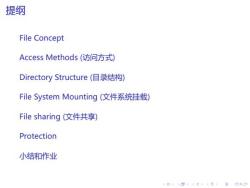
提纲 File Concept Access Methods(访问方式) Directory Structure(目录结构) File System Mounting(文件系统挂载, File sharing(文件共享) Protection 小结和作业 4口”4814在,4色,主)QC
. . . . . . . . . . . . . . . . . . . . . . . . . . . . . . . . . . . . . . . . 提纲 File Concept Access Methods (访问方式) Directory Structure (目录结构) File System Mounting (文件系统挂载) File sharing (文件共享) Protection 小结和作业
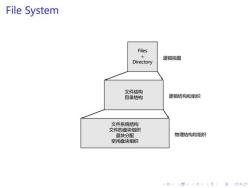
File System Files 逻辑视图 Directory 文件结构 目录结构 逻辑结构和组织 文件系统结构 文件的盘块组织 盘块分配 物理结构和组织 空闲盘块组织 口·484在,4生,主Q0
. . . . . . . . . . . . . . . . . . . . . . . . . . . . . . . . . . . . . . . . File System 逻辑视图 逻辑结构和组织 物理结构和组织 文件系统结构 文件的盘块组织 盘块分配 空闲盘块组织 文件结构 目录结构 Files + Directory

Chapter Ojbectives To explain the function of file systems To describe the interfaces to file systems To discuss file-system design tradeoffs,including access methods,file sharing,file locking,and directory structures To explore file-system protection 4口”4814在,4色,主)QC
. . . . . . . . . . . . . . . . . . . . . . . . . . . . . . . . . . . . . . . . Chapter Ojbectives ▶ To explain the function of file systems ▶ To describe the interfaces to file systems ▶ To discuss file-system design tradeoffs, including access methods, file sharing, file locking, and directory structures ▶ To explore file-system protection

Outline File Concept 4口”484在4色,主月QC
. . . . . . . . . . . . . . . . . . . . . . . . . . . . . . . . . . . . . . . . Outline File Concept
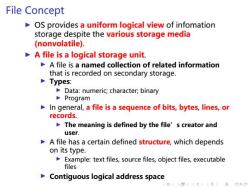
File Concept OS provides a uniform logical view of infomation storage despite the various storage media (nonvolatile). A file is a logical storage unit. A file is a named collection of related information that is recorded on secondary storage. Types: Data:numeric;character;binary Program In general,a file is a sequence of bits,bytes,lines,or records. The meaning is defined by the file's creator and user. A file has a certain defined structure,which depends on its type. Example:text files,source files,object files,executable files Contiguous logical address space 145+4在4生,主月QC
. . . . . . . . . . . . . . . . . . . . . . . . . . . . . . . . . . . . . . . . File Concept ▶ OS provides a uniform logical view of infomation storage despite the various storage media (nonvolatile). ▶ A file is a logical storage unit. ▶ A file is a named collection of related information that is recorded on secondary storage. ▶ Types: ▶ Data: numeric; character; binary ▶ Program ▶ In general, a file is a sequence of bits, bytes, lines, or records. ▶ The meaning is defined by the file’s creator and user. ▶ A file has a certain defined structure, which depends on its type. ▶ Example: text files, source files, object files, executable files ▶ Contiguous logical address space
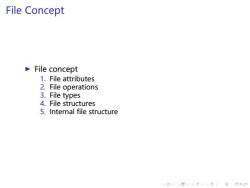
File Concept File concept 1.File attributes 2.File operations 3.File types 4.File structures 5.Internal file structure 4口”4814在,4色,主)QC
. . . . . . . . . . . . . . . . . . . . . . . . . . . . . . . . . . . . . . . . File Concept ▶ File concept 1. File attributes 2. File operations 3. File types 4. File structures 5. Internal file structure

1.File Attributes(文件属性) A file's attributes vary from one OS to another but typically consist of these: Name-The only information kept in human-readable form A name is usually a string of characters,such as "example.c" Uppercase vs.lowercase:care or not care Identifier-Unique tag,usually a number,identifies file within FS The non-human-readable name for the file Type-Needed for systems that support different types Location-A pointer to file location on device Size-Current file size;may also include MAX size =Protection-Access-control(访问控制)information: who can do reading,writing,executing Time,date,and user identification-Data for protection,security,and usage monitoring 口”484在年生”主)QC
. . . . . . . . . . . . . . . . . . . . . . . . . . . . . . . . . . . . . . . . 1. File Attributes (文件属性) ▶ A file’s attributes vary from one OS to another but typically consist of these: ▶ Name – The only information kept in human-readable form ▶ A name is usually a string of characters, such as “example.c” ▶ Uppercase vs. lowercase: care or not care ▶ Identifier – Unique tag, usually a number, identifies file within FS ▶ The non-human-readable name for the file ▶ Type – Needed for systems that support different types ▶ Location – A pointer to file location on device ▶ Size – Current file size; may also include MAX size ▶ Protection – Access-control (访问控制) information: who can do reading, writing, executing ▶ Time, date, and user identification – Data for protection, security, and usage monitoring

1.File Attributes(文件属性) Information about files are kept in the directory structure,which is also maintained on the secondary storage other all file file attributes attributes identifier identifier name name directory structure 1 directory structure 2 Typically,a directory entry only consists of the file's name and its unique identifier. The identifier in turn locates the other file attributes
. . . . . . . . . . . . . . . . . . . . . . . . . . . . . . . . . . . . . . . . 1. File Attributes (文件属性) ▶ Information about files are kept in the directory structure, which is also maintained on the secondary storage all file attributes identifier name directory structure 1 identifier name other file attributes directory structure 2 ▶ Typically, a directory entry only consists of the file’s name and its unique identifier. The identifier in turn locates the other file attributes
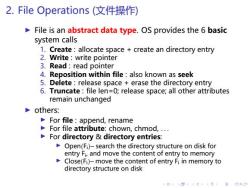
2.File Operations(文件操作) File is an abstract data type.OS provides the 6 basic system calls 1.Create:allocate space create an directory entry 2.Write:write pointer 3.Read:read pointer 4.Reposition within file:also known as seek 5.Delete:release space erase the directory entry 6.Truncate:file len=0;release space;all other attributes remain unchanged others: For file:append,rename For file attribute:chown,chmod,... For directorydirectory entries: Open(Fi)-search the directory structure on disk for entry Fi,and move the content of entry to memory Close(Fi)-move the content of entry Fi in memory to directory structure on disk 口4香4三,4兰主刀Q0
. . . . . . . . . . . . . . . . . . . . . . . . . . . . . . . . . . . . . . . . 2. File Operations (文件操作) ▶ File is an abstract data type. OS provides the 6 basic system calls 1. Create : allocate space + create an directory entry 2. Write : write pointer 3. Read : read pointer 4. Reposition within file : also known as seek 5. Delete : release space + erase the directory entry 6. Truncate : file len=0; release space; all other attributes remain unchanged ▶ others: ▶ For file : append, rename ▶ For file attribute: chown, chmod, . . . ▶ For directory & directory entries: ▶ Open(Fi)– search the directory structure on disk for entry Fi , and move the content of entry to memory ▶ Close(Fi)– move the content of entry Fi in memory to directory structure on disk

2.File Operations(文件操作) Open Files Open-File Table Open-file table,OFT:a small table containing information about all open files Several processes may open the same file at the same time 2-levels:a per-process table a system-wide table with process-independent information OFT process P system OFT OFT process P2 口”484在4色”主)QC
. . . . . . . . . . . . . . . . . . . . . . . . . . . . . . . . . . . . . . . . 2. File Operations (文件操作) ▶ Open Files & Open-File Table ▶ Open-file table, OFT: a small table containing information about all open files ▶ Several processes may open the same file at the same time ⇒2-levels: a per-process table & a system-wide table with process-independent information OFT process P1 OFT process P2 system OFT
按次数下载不扣除下载券;
注册用户24小时内重复下载只扣除一次;
顺序:VIP每日次数-->可用次数-->下载券;
- 中国科学技术大学:《操作系统原理与设计 Operating System》课程教学资源(PPT课件讲稿)09 虚拟内存 Virtual Memory.pdf
- 中国科学技术大学:《操作系统原理与设计 Operating System》课程教学资源(PPT课件讲稿)08 Main Memory.pdf
- 中国科学技术大学:《操作系统原理与设计 Operating System》课程教学资源(PPT课件讲稿)07 Deadlock.pdf
- 中国科学技术大学:《操作系统原理与设计 Operating System》课程教学资源(PPT课件讲稿)06 Process Synchronization.pdf
- 中国科学技术大学:《操作系统原理与设计 Operating System》课程教学资源(PPT课件讲稿)05 Threads.pdf
- 中国科学技术大学:《操作系统原理与设计 Operating System》课程教学资源(PPT课件讲稿)04 CPU Scheduling.pdf
- 中国科学技术大学:《操作系统原理与设计 Operating System》课程教学资源(PPT课件讲稿)03 Processes.pdf
- 中国科学技术大学:《操作系统原理与设计 Operating System》课程教学资源(PPT课件讲稿)02 OS Structure.pdf
- 中国科学技术大学:《操作系统原理与设计 Operating System》课程教学资源(PPT课件讲稿)01 CS Structure.pdf
- 中国科学技术大学:《操作系统原理与设计 Operating System》课程教学资源(PPT课件讲稿)01 OS overview.pdf
- 中国科学技术大学:《操作系统原理与设计 Operating System》课程教学资源(PPT课件讲稿)课程简介(主讲:陈香兰).pdf
- 中国科学技术大学:《高级操作系统 Advanced Operating System》课程教学资源(PPT课件讲稿)第二章 分布式路由算法(2/2).ppt
- 中国科学技术大学:《高级操作系统 Advanced Operating System》课程教学资源(PPT课件讲稿)第二章 分布式路由算法主要内容(1/2,主讲:陈香兰).ppt
- 天津开放大学:《电子商务概论》课程教学资源(试卷习题)综合练习及答案.doc
- 国家开放大学:《计算机应用基础》课程教学资源(章节习题,含答案)计算机网络应用基础练习_第三章.doc
- 国家开放大学:《计算机应用基础》课程教学资源(章节习题,含答案)计算机安全练习_第七章.doc
- 国家开放大学:《计算机应用基础》课程教学资源(章节习题,含答案)计算机基础知识练习_第一章.doc
- 国家开放大学:《计算机应用基础》课程教学资源(章节习题,含答案)Word 2010文字处理系统练习_第四章.doc
- 国家开放大学:《计算机应用基础》课程教学资源(章节习题,含答案)Windows 7操作系统及应用练习_第二章.doc
- 国家开放大学:《计算机应用基础》课程教学资源(章节习题,含答案)PowerPoint 2010电子演示文稿系统练习_第六章.doc
- 中国科学技术大学:《操作系统原理与设计 Operating System》课程教学资源(PPT课件讲稿)11 File 文件系统实现 File system implementation.pdf
- 中国科学技术大学:《操作系统原理与设计 Operating System》课程教学资源(PPT课件讲稿)12 外存 Mass Storage Systems.pdf
- 中国科学技术大学:《操作系统原理与设计 Operating System》课程教学资源(PPT课件讲稿)13 IO管理 IO systems.pdf
- 中国科学技术大学:《Linux操作系统分析》课程教学资源(课件讲义)GNU开发工具链简介 GNU Tools(主讲:陈香兰).pdf
- 中国科学技术大学:《Linux操作系统分析》课程教学资源(课件讲义)基于x86的Linux启动代码分析.pdf
- 中国科学技术大学:《Linux操作系统分析》课程教学资源(课件讲义)制作简单的Linux系统.pdf
- 中国科学技术大学:《Linux操作系统分析》课程教学资源(PPT课件讲稿)内存寻址.ppt
- 中国科学技术大学:《Linux操作系统分析》课程教学资源(PPT课件讲稿)Linux进程管理(1/3).ppt
- 中国科学技术大学:《Linux操作系统分析》课程教学资源(PPT课件讲稿)Linux进程管理(2/3).ppt
- 中国科学技术大学:《Linux操作系统分析》课程教学资源(课件讲义)中断和异常.pdf
- 中国科学技术大学:《Linux操作系统分析》课程教学资源(课件讲义)系统调用.pdf
- 中国科学技术大学:《Linux操作系统分析》课程教学资源(PPT课件讲稿)Linux进程管理(3/3).ppt
- 中国科学技术大学:《Linux操作系统分析》课程教学资源(课件讲义)内存管理.pdf
- 中国科学技术大学:《Linux操作系统分析》课程教学资源(课件讲义)Linux中的时钟和定时测量.pdf
- 中国科学技术大学:《Linux操作系统分析》课程教学资源(课件讲义)Linux中的进程地址空间.pdf
- 中国科学技术大学:《Linux操作系统分析》课程教学资源(课件讲义)程序的执行.pdf
- 中国科学技术大学:《Linux操作系统分析》课程教学资源(PPT课件讲稿)文件系统.ppt
- 中国科学技术大学:《Linux操作系统分析》课程教学资源(PPT课件讲稿)管理I/O设备.ppt
- 中国科学技术大学:《Linux操作系统分析》课程教学资源(PPT课件讲稿)Linux中的信号机制.ppt
- 中国科学技术大学:《Linux操作系统分析》课程教学资源(PPT课件讲稿)进程的同步和通信.ppt
